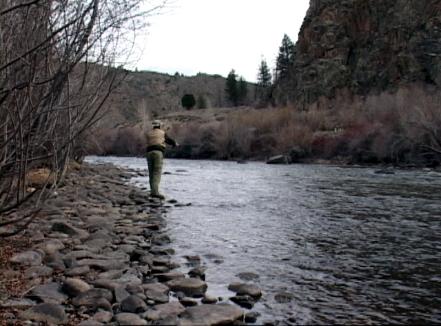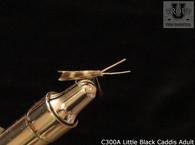
The Gunnison River is often considered one of Colorado's best trout streams. It is versatile since it is both a freestone stream and a tailwater stream, and it offers fly fishing opportunities with various species of trout as well as salmon.
The Gunnison River, a tributary of the Colorado River is 165 miles long and originates by the joining of the East River and the Taylor River at Almont, Colorado. After passing the small town of Gunnison, Colorado, the river enters the Blue Mesa Reservoir which is 36 miles long. The section above the Reservoir is often referred to as the upper section. Going downstream from the Blue Mesa Dam, the river enters the Morrow Point Reservoir and after that, the river is dammed again to form the Crystal Reservoir. The section of the Gunnison from the Blue Mesa Dam down to the confluence of the North Fork is generally called the lower portion of the Gunnison. It includes the Black Canyon of Gunnison which is one of the narrowest and the longest gorges in the world.
It is important to point out the two major sections of the Gunnison since they are entirely different. The upper portion is greatly affected by the spring runoff. It is high and wild during May and some parts of June depending on the winter conditions. The upper Gunnison River behaves like a freestone river even though the Taylor, one of the streams that form it, is a tailwater stream. Also, several tributary streams like the Ohio Creek and the Antelope Creeks are freestone streams as well further contributing to its freestone nature.
Trout can be caught before runoff using midge larvae imitations as well as other nymphs, however, the more productive fishing will usually start around the end of June. The first big hatch to occur is the well known salmonfly hatch which usually starts about that time. By the time you get into July, you can start with dry flies and mid August will see the Kokanee salmon run up the Gunnison from the the Blue Mesa Reservoir to spawn. There's a "catch-and-release" season for the Kokanee that extends from August 1st to October 31st; and although the salmon must be released into the river, it provides some great fishing using streamers. The large brown trout will leave the Blue Mesa Reservoir and run up river to spawn starting in October. This run provides some excellent trout fishing as well.
The lower section of the Gunnison is the beautiful and relatively untouched wilderness area known as the Black Canyon. This section is a tailwater stream consisting mostly of pocket water with deep pool, riffles and runs with the flow controlled by the releases from the Blue Mesa Dam. This lower section contains an abundance of large brown trout that average from 15 to 18 inches as well as some rainbows.
Water from the upstream boundary of the Black Canyon in the Gunnison National Park downstream to the North Fork of the Gunnison River, is classified by the state of Colorado as Gold Medal Water. This designation indicates that this part of the river is among the best of the state's trout waters. During times of high water, the Gunnison can be best fished by using drift boats but at other times it can be waded safely.
Spring:
Other than the midges which are present in the Gunnison all year long, the Blue-winged Olives are probably the most plentiful species of aquatic insects. They start to hatch about the middle of April and last until mid May. These insects are bi-brooded and hatch again about the middle of July and continue through October, depending on the location. Western March Browns hatch from about the first of April through the first week or two in May. The Salmonfly hatch is the major hatch of the season starting in the first of June and the last week of June will see the Pale Morning Duns, or PMDs, start to hatch; and this hatch will often continue into early September. LIttle Short-horned Sedges hatch from May through the month of June.
Summer:
Several species of Stoneflies are included on the list of most important insects. The Giant Salmonflies are present especially in the Canyon section of the river and they hatch from about the first of June through the first week or two in July. Golden Stoneflies hatch from around the last of June through the month of July and into the first week or two of August, depending on the location. The little Yellow Stoneflies and the Little Green Stoneflies hatch from the middle of July through most of August.
Summer will see the PMDs continue to hatch into early September. Some areas of the Gunnison will see the Green Drakes start to hatch around the first of July and the hatch will last into the middle of August. July and August will see the hatches of the Red Quills as well. Spotted Sedges are present from June through the month of September and the Great Gray Spotted Wing Sedges will hatch during July and August. Also for the Kokanee salmon run be sure to have a good supply of streamers. These salmon will not eat during the spawning run but they will attack attractor type streamers.
Fall:
Some of the previous hatches will continue through into the fall including the bi-brooded BWOs and terrestrials will be productive in the summer as well as early fall. These include the grasshoppers, ants, beetles and black flies. Imitations of Sculpin and various baitfish will be productive in the fall, when the brown trout spawning.
Aquatic insects are plentiful on the Gunnison and to take full advantage of the numerous species; we recommend our line of trout flies simply because we at Troutprostore have the most realistic and effective trout flies you can purchase. These flies are carefully tied to imitate the actual insect making it possible to closely match the hatch. Unlike the generic fly shop trout flies, we have specific imitations of all the insects in the Gunnison River and more importantly, in all stages of life that are applicable to fishing. Remember, if you want to fish better, more realistic trout flies, have a much higher degree of success.
There are several public access points for anglers to wade the river. The river can be fished by hiking down into the canyon and camping at one of the designated campsites. However, it should be noted that access to the canyon is strictly controlled in order to preserve the beauty of the natural wilderness





